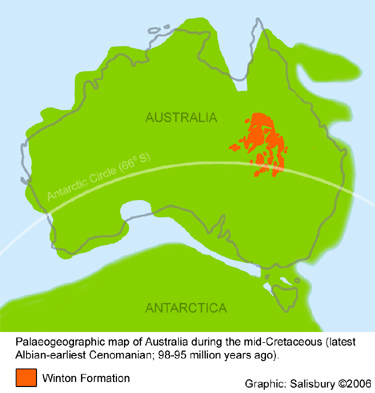The Winton Formation

years ago, showing the extent of the Winton
Formation. ©2006 Steve Salisbury.
Age
Early Cretaceous (98-95 million years old; latest Albian-earliest Cenomanian)
Notes
The Winton Formation is a rock unit that blankets large areas of central-western Queensland. It consists of sedimentary rocks such as sandstone, siltstone and claystone. The sediments that make up these rocks represent the remnants of the river plains that filled the basin left by the Eromanga Sea - an inland sea that covered large parts of Queensland and central Australia at least four times during the Early Cretaceous. Great meandering rivers, forest pools and swamps, creeks, lakes and coastal estuaries, all left behind a different type of sediment.
In some areas, the Winton Formation is over 400 metres thick. To bring with them such a huge amount of sediment, the rivers that flowed across these plains must have been comparable in size to the present day Amazon or Mississippi. As more and more sediment was brought in, the margins of the inland sea slowly contracted. By around 95 million years ago, the job was complete and the inland sea would never be seen again.
By virtue of its age and the environmental conditions under which the rocks it consists of were deposited, the Winton Formation represents one of the richest sources of dinosaur fossils anywhere in Australia.
Winton Formation fossils
Isisfordia duncani - the world's first modern croc
The Winton sauropods
Other fossils from the Winton Formation
